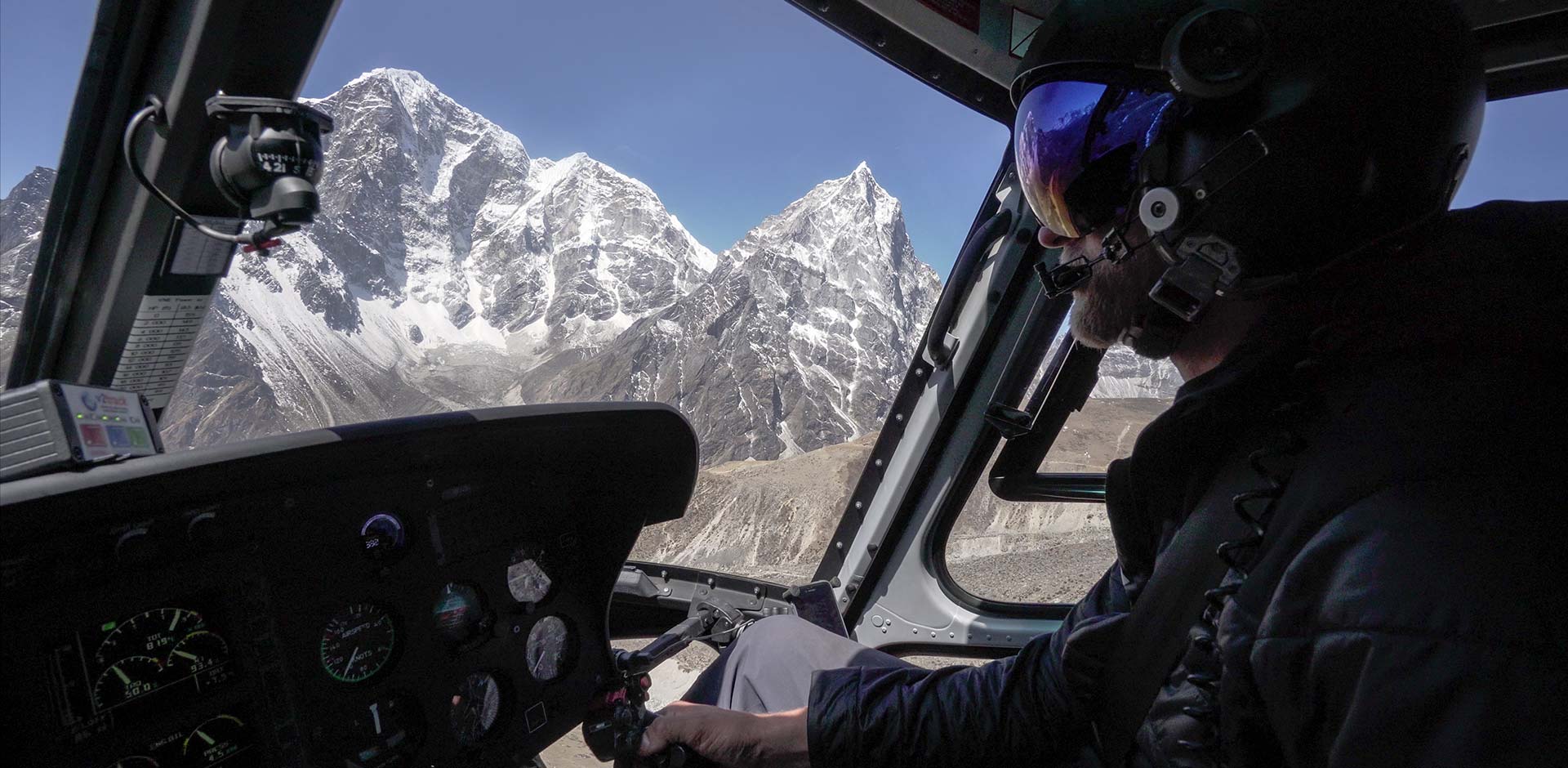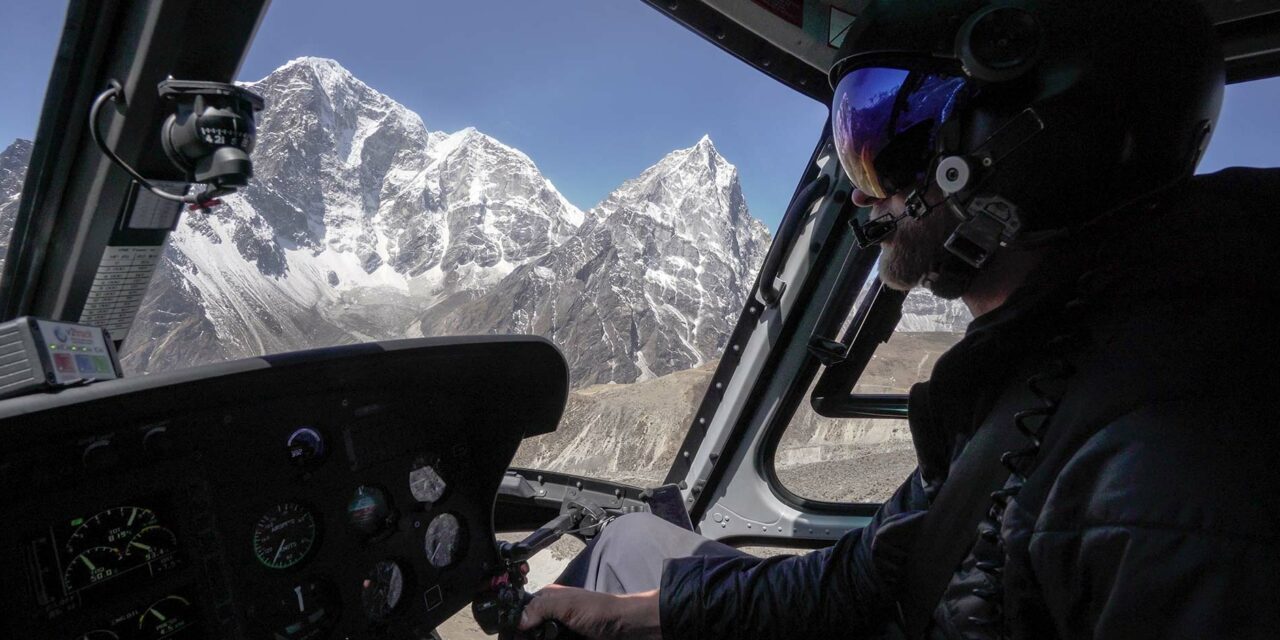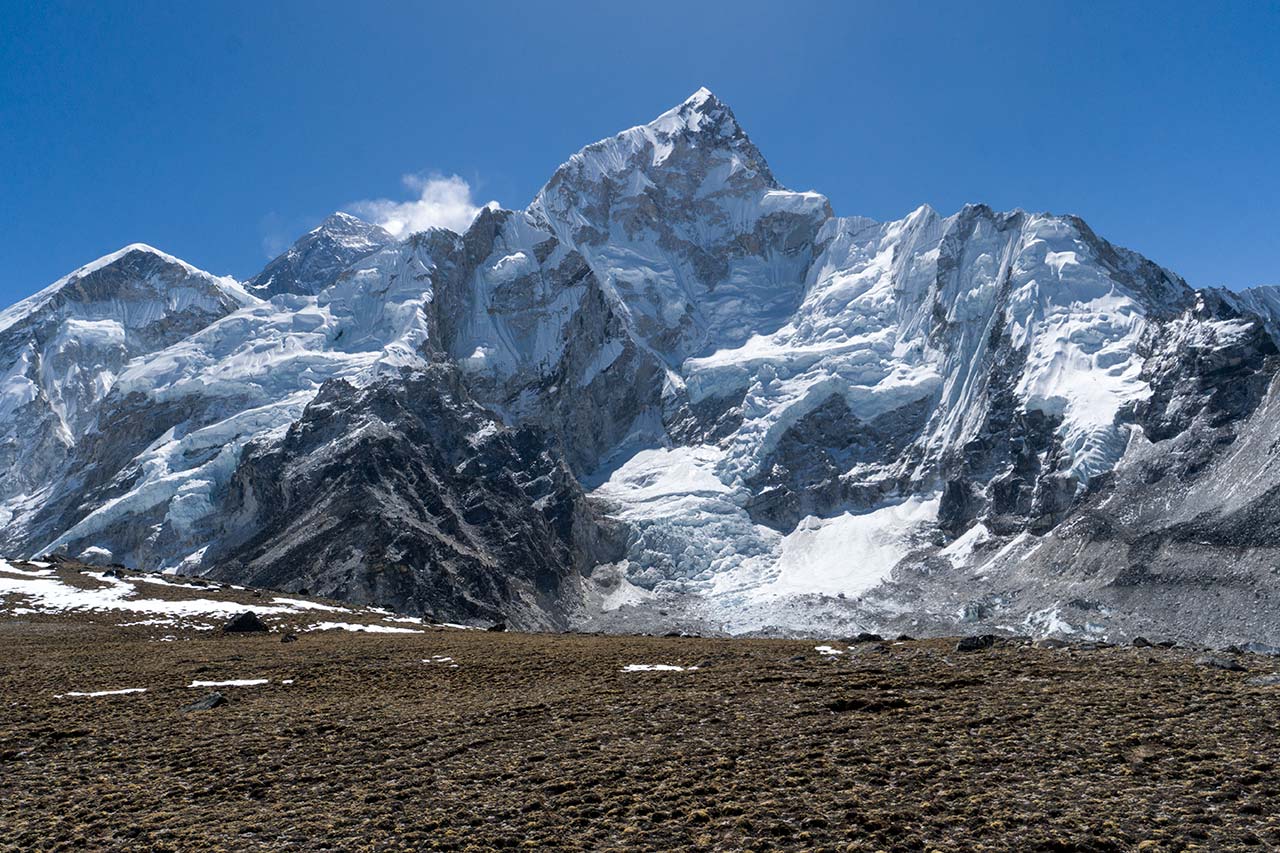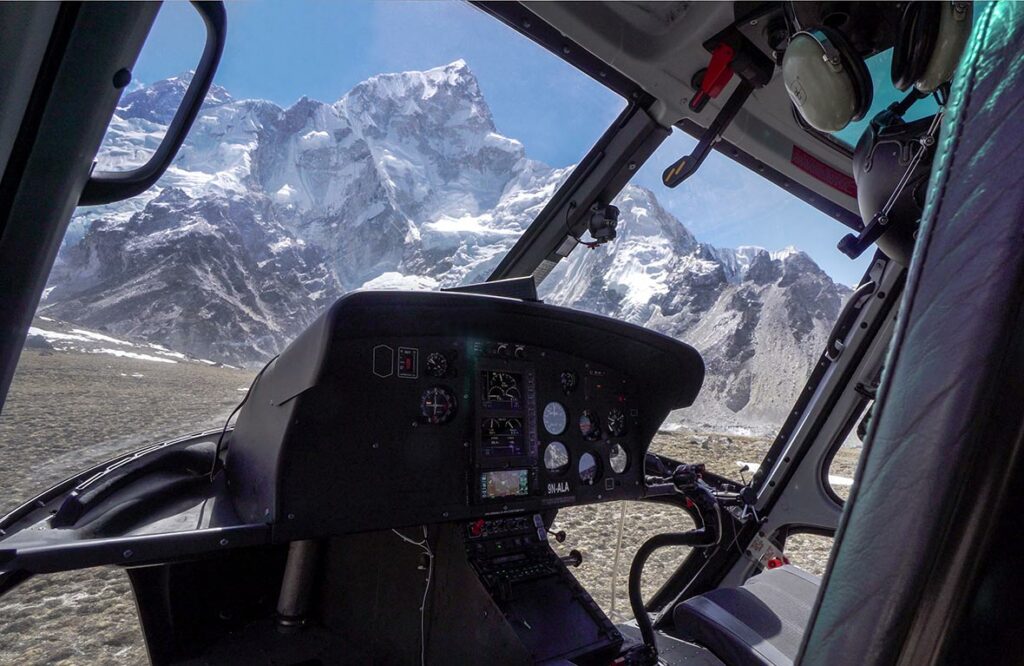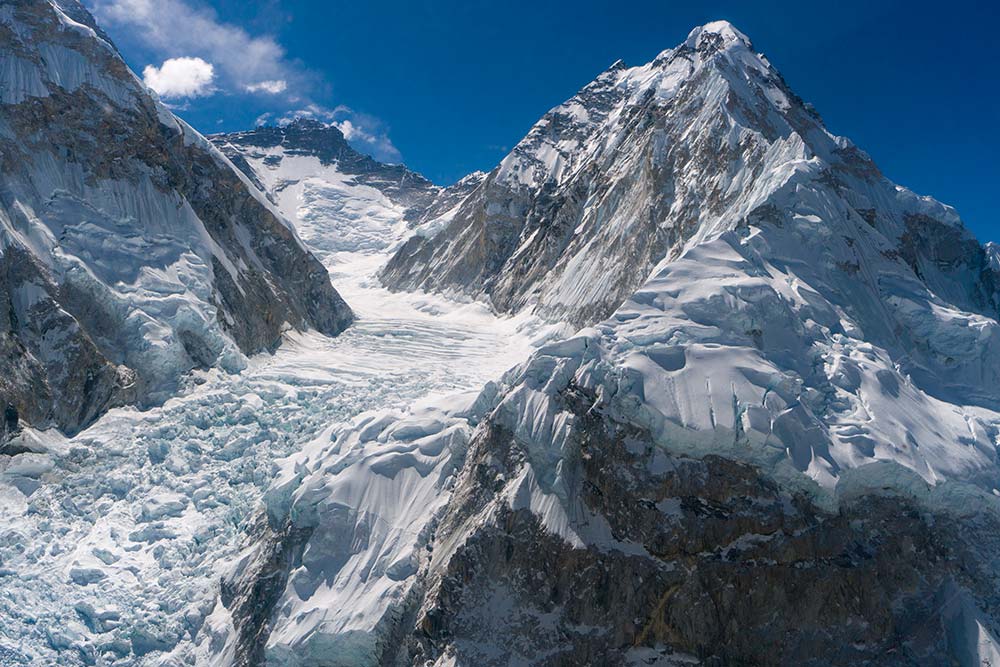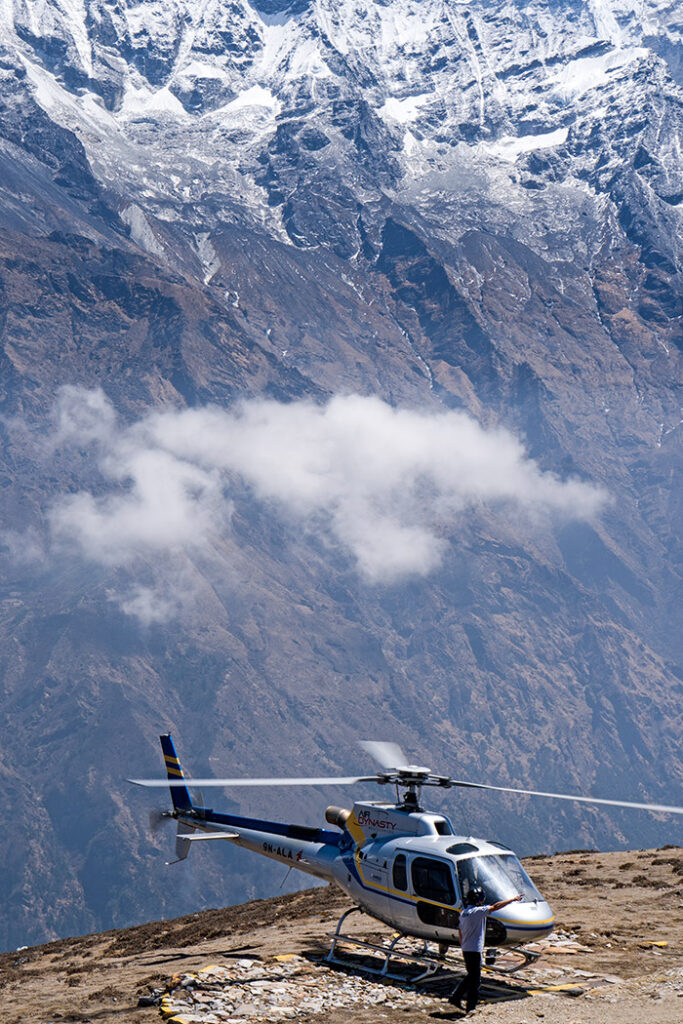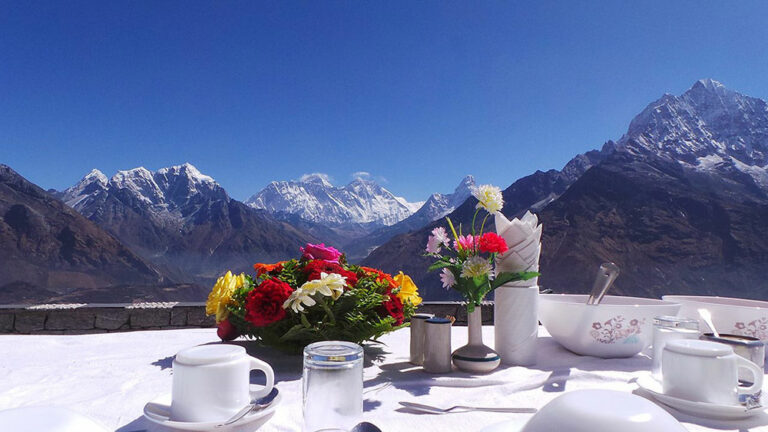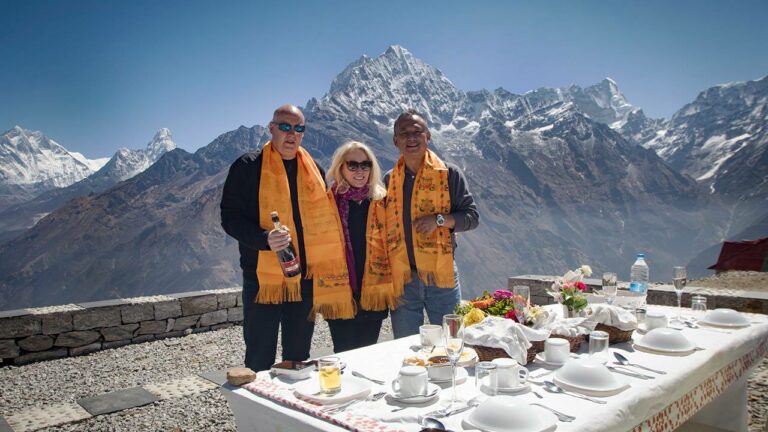“Your lips are turning blue,” said the Kiwi pilot, shouting over the roaring chopper. “That’s the first sign of altitude sickness.”
The helicopter roared. If the blades are turned off, the helicopter won’t start again in the thin, dry air. Mountaineers struggle and sacrifice for this view – popping blood thinners and trekking eight days to acclimatize – some never getting this far. But there is a short cut.
“Seven minutes max,” he warned.
Precious seconds ticked by – each one a unique, fleeting moment. I had only taken off from Kathmandu a little over an hour ago; yet, there I stood, staring at the Khumbu Icefall at 18,000 feet.
I was confident that I could last 15 or 20 minutes, but the human body owes the Himalayas a toll. Fast or slow, everyone pays.
The Quick Way Up
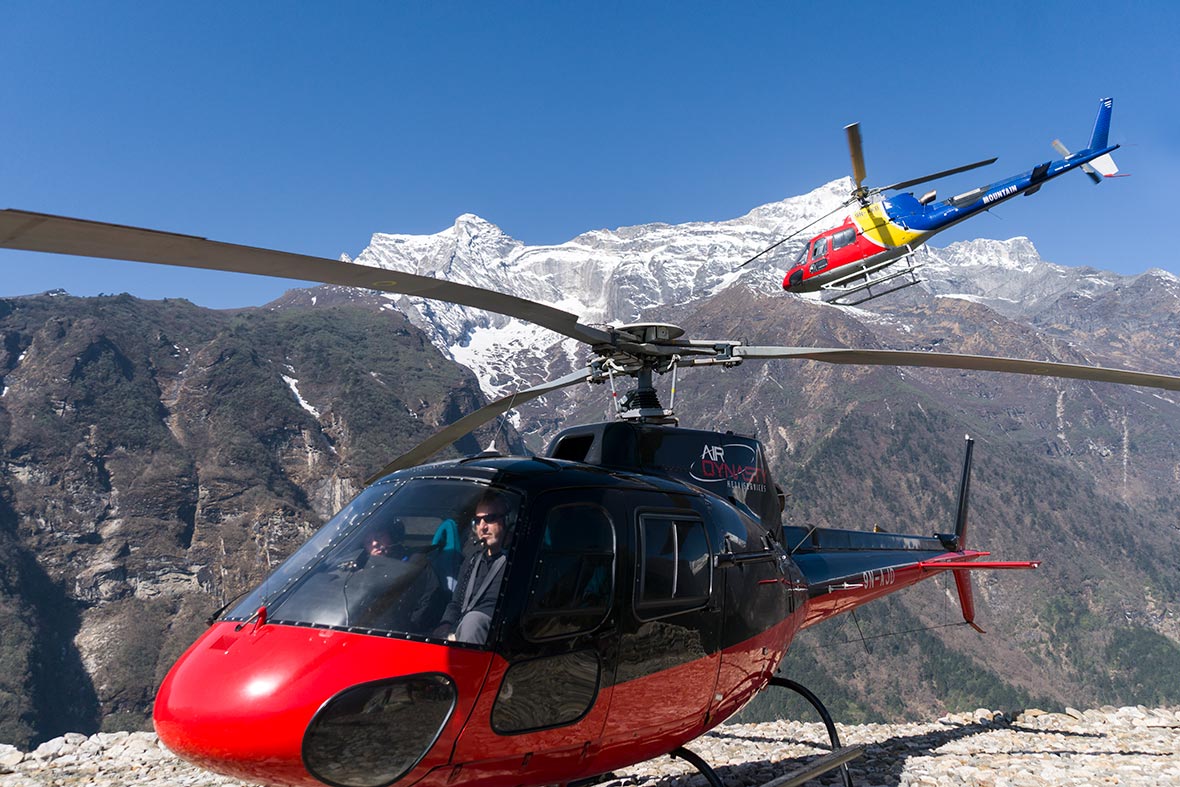
ABOVE: Changing choppers at the Syangboche airstrip at Namche Bazaar, a busy high-altitude helicopter landing area in the Himalayas.

Andrew saves lives from one of the most inhospitable environments on Earth.

We took off in the early morning light from Kathmandu shrouded in fog, weather that did not bode well for the trip. The climate at the top of the world is no respecter of itineraries. We were meant to land at Lukla, often referred to as the most dangerous airport on earth.
Named after those immortal summiters, the Tenzig-Hillary Airport comes through a mountain pass to a thin runway. It is also the home of our intrepid pilot, Andrew Gutsell: confident, charismatic, and almost annoyingly cool. Apart from taking tourists on a jolly jaunt on the roof of the world, Andrew saves lives from one of the most inhospitable environments on Earth.
Just a few months ago Andrew made international news as the hero of a dramatic rescue mission in which he and two others saved critically-injured survivors from a plane crash dripping with highly flammable jet fuel on the edge of the cliff face. That, ladies and gentlemen, was our driver.
VIDEO: The trip stretches through the long, jagged landscape of the Himalayas to Kalapattar, where Everest can be seen in all its majesty, and 3,000 feet down is a chance for rest and reflection.
Leaving Kathmandu in the direction of Everest, the weather began to clear; dry earth and white capped mountains poked defiantly at a bright blue sky. Still though, we could not land at the Tenzig-Hillary Airport due to heavy air traffic. Instead, we were pointed toward a landing strip at at Namche Bazaar.
Namche has much to compliment it, apparently: views of the Himalayas, a Tibetan market on Saturdays, and even the odd internet café. Our location, however, was the airport, which is notably unpaved. Helicopters land on the busy, dirt patch and take off one after the other, feeling more like a scene out of Apocalypse Now than Shangri-La in Lost Horizon.

I had gone from 6,000 feet to 18,000 feet in the span of an hour; the body isn’t meant to do that. Breaths began to feel empty.

Our flight gave us unique views of Dingboche, Gorakshep, and Tengboche; surely only those brave souls summiting can brag of a better view. The Khumbu glacier was one of the greater sites, a plain of ice funneled through the mountains by gravity itself. The most famous section of the glacier is the Khumbu Icefall, the first main obstacle climbers face on their long journey.
Stepping onto Kalapathar, the view of Everest heaves into view. Ahead is the Khumbu Icefall, below Base Camp – filled with brightly-colored tents and humanity, as well as the rubbish they leave in their wake.
“This is the highest point in the world that we can fly, apart from rescues,” Andrew said as we landed.
The helicopter roaring, the scene may not sound peaceful, but that’s the beauty of Everest and the Himalayas. So stunning are they that they blot out the rest.
Through slow introduction and grit, the local Sherpas and people like Andrew have adapted to life in the clouds, but I hadn’t. It can take more than 10 days to hike to Kalapatthar, during which the mountaineers slowly grow accustomed to the desperately thin air. I had gone from 6,000 feet to 18,000 feet in the span of an hour; the body isn’t meant to do that. Breaths began to feel empty.

ABOVE: The helicopter whirls on Kalapattar. If the blades stop, they won’t start again in that dangerous, high-altitude environment.
When I stepped out, full of the vigor of the veteran photographer, I was sure I’d be able to take more than the average traveler. Feeling my head get light and the world go peculiar, I began capturing what I could with my camera.
Leaving the imposing, dangerously magical Mount Everest, my business partner and fellow traveler and I boarded the helicopter, she taking pulls from an oxygen canister.
I had seen so much from the helicopter – the highest mountains on the planet from the vantage of the gods – but there is something so terribly human about staring at Everest with your feet planted, a feeling of proportion. With that feeling of humanity came the frailty, and after seven minutes in heaven, I was forced to return to earth – for breakfast.
ABOVE: Around 3,000 feet below Kalapattar is Kongde, where the helicopter can rest and the traveler can eat and take in a panoramic view of Everest and the Himalayas.
When Remote Lands began featuring the tour, much was made of the breakfast at Everest: The Telegraph, The Daily Mail, SCMP. Bloomberg ran with the headline: “How to Have Breakfast 18,000 Feet Up Mount Everest,” which is slightly inaccurate.
Breakfast at 18,000 feet might leave you passed out in your eggs and sausage, but 3,000 feet down from Kalapatthar is Kongde, an opportunity for 40 minutes of unencumbered peace. Catherine offered me a hit from her oxygen, but the air is surprisingly more amenable just 3,000 feet below.
For the uninitiated, the breakfast simply seems like decadence, like a fanciful trip to conspicuously consume, but with this view is a palpable spirituality. This is a place of comfort, a place to reflect. I had darted through snow-capped paradise and spent seven minutes suffocating in the heaven of the Himalayas. And then I was having bacon.
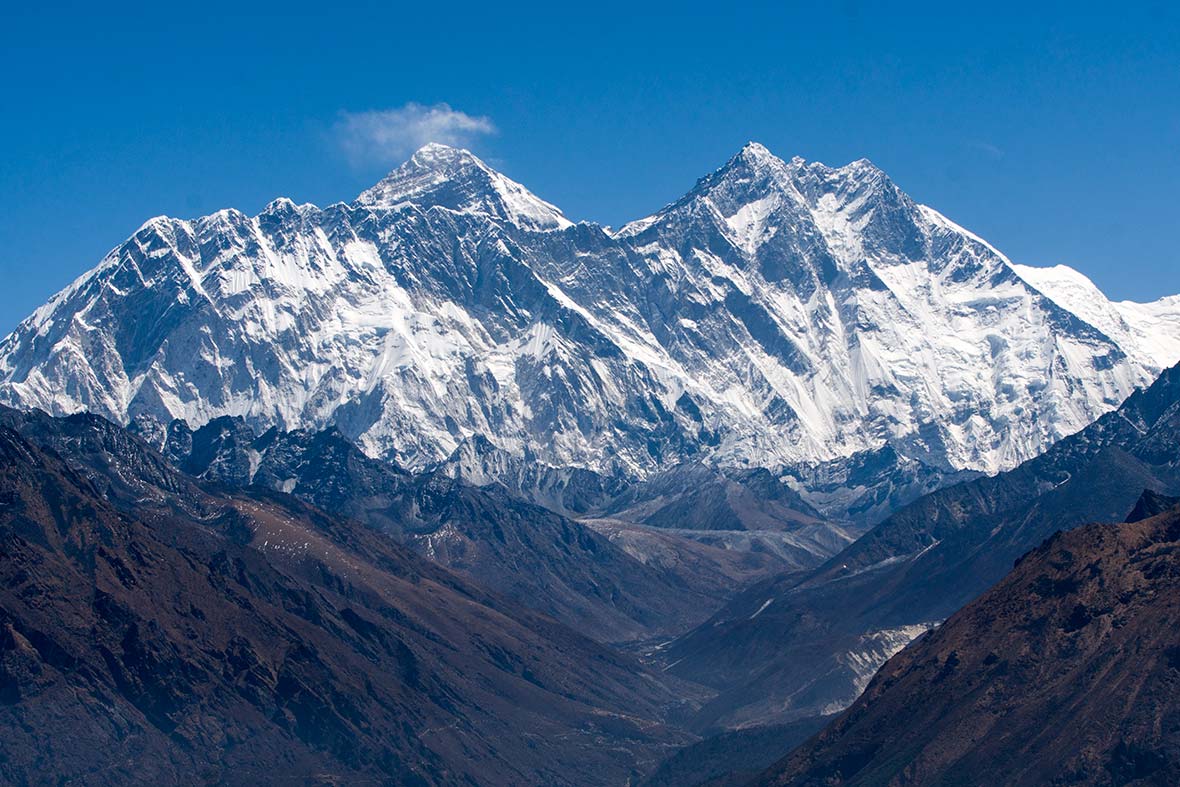

Everest is actually around the same latitude as Florida, so breakfast can be had in short sleeves if one is so inclined.

I was given a traditional khata before my meal, a scarf given with a humble bow as I moved to my set table for breakfast – ushering me toward a panoramic view of the Himalayas. The ice, snow, and glaciers of the Himalayas scare off some would-be travelers, but Everest is actually around the same latitude as Florida, so breakfast can be had in short sleeves if you’re so inclined.
Everest is visible from Kongde, as are Lhotse, Makalu, Ama Dablam, and half a dozen other famous mountains. The luxury lodge, Yeti Mountain Lodge, is on the route from Thame to Kongde, used by the Khumbu Sherpas before the 1950s. That purpose seems lost now. How could Kongde be anywhere but the destination? Who would willingly move on?
For us, though, after 40 minutes of admiration in Kongde, our time at Everest had come to an end. From Kathmandu to landing at the Tenzig-Hillary Airport to depart, it had taken three hours.

So remarkable was the short trip that it almost seemed as though it didn’t happen, that it couldn’t have been real, like I had been yanked between worlds and thrown back. The evidence, however, was in my camera, and as time moved on, the sights grew more vivid in my mind. Those who hike along the ground see Everest more closely, but, for those taking the short cut, it is seen with surprise and severity.

